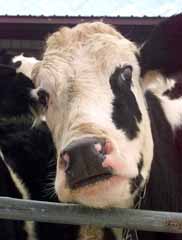USU researchers make progress on mad cow disease
Utah State University students and professors are researching prion diseases such as mad cow disease.
Concern about the spread of the disease escalated when an infected cow was found in the United States December.
USU’s program is part of the Institute of Anti-Viral Research at USU and is funded by the federal government’s National Institute of Health (NIH). The idea to investigate a category of infections called prion diseases came from NIH and was proposed as a precautionary measure, with the anticipation of possible outbreaks of mad cow disease.
Researchers at USU have been working on the investigation for two years.
Although an outbreak in human infection has not yet occurred in the United States, said John Morrey, animal dairy and veterinary sciences research professor, the research is currently looking for therapies that can work against the disease.
“Prions cause holes in the brain,” said Justin Julander, who is studying for his doctorate in animal science. “A person or animal may have neurological disorders as symptoms because of the holes in the brain.”
Morrey said, “Our purpose is to identify treatment for the prion disease, because prions are protein particles thought to cause the disease. Mad cow is one of the many forms of prions.”
Basically, mad cow disease takes place when normal proteins make a confirmation (change in shape) of other normal proteins to an abnormal form, and then abnormal proteins make confirmations of other proteins.
The goal of the research involves investigating and testing medications on rodents, hoping to find a medication that would stop and reverse the confirmation process of the proteins, thus stopping the disease.
Because of specific symptoms in different infected animals, diseases caused by prions are referred to differently.
Infected humans are referred to have Creutzfeldt-Jakob Disease or vCJD, if tainted meat is consumed. Bovine Spongiform Encephalopathy (BSE) is the disease in cows (mad cow disease). Chronic Wasting Disease is restricted to deer and elk. Sheep get “scrapies,” the name coming from the way the animal would scrape itself against objects because of chronic itching symptoms.
Prion diseases are generally specific to a species barrier and all forms have specific symptoms to its species.
“There has been no reported incident that people have been getting the [scrapies] disease from sheep, mink or rodents, so the fact that people did get it from infected cows [in Great Britain] is an anomaly,” Morrey said.
Ken Allen, who does research and takes care of the rodents while performing experiments with them, said, “The research is done with the use of experimentally infected rodents.”
Allen, a senior majoring in biology, said he wants to become a dentist and hopes this research experience will assist him with his dental school application.
“I was looking for a research job and this went along with what I wanted to do,” he said.
“We work with mice that are genetically engineered to have a shorter latency to the disease,” Allen said, adding that the disease can show up within two to three months, as opposed to 10 months for a rodent that is not genetically engineered.
“So, we can do the experiment and get the results faster,” he said.
Although researchers from USU have not yet found any beneficial medications to reverse the confirmation process or that can be given therapeutically after signs of disease occurrence, they say there is still hope.
“Based on the biochemistry of the disease, there is hope that treatment can be found to help it,” Morrey said.
However, there are also drugs given to the mice before they have been experimentally infected with mad cow disease, which can strongly delay the offset of the disease.
Clell Bagley, Extension veterinarian and program leader of agriculture and natural resources department, works cooperatively with the USU’s research team and the people of Utah. Bagley said he thinks BSE shouldn’t be ignored and believes protection of food supply can be done through procedures such as those that are being implemented through the United States Department of Agriculture.
The USDA has implemented restrictions that are imposed to prevent imports of beef with BSE. After BSE was reported in beef from Great Britain in 1986, the country’s meat was excluded. Similar rules have been applied to other BSE cases such as Canada’s last May.
The ban on feeding ruminant (such as cattle or sheep) protein back to other ruminants is another USDA restriction that has been in place since 1997 to prevent BSE cases. Re-feeding ruminants was one of the main reasons BSE spread to other cattle in the United Kingdom.
The Food and Drug Administration is also involved and implementing changes in harvesting techniques during slaughter to prevent contamination of meat products in case BSE is found.
“The actual risk of anyone in the U.S. becoming infected is much less than the risk of him or her being killed [from falling] as they take a bath or shower,” Bagley said.
All research that is done will be submitted to scientific peer-reviewed journals that only get published if other critical scientists review the researched material.
“When the researched material passes the peer review, there is a fairly good confidence in the quality level of the information,” Morrey said.
The total amount granted by the government is contracted for USU to research many other diseases, such as the West Nile virus. The entire program is solely funded by grants. The government makes a review of the research every five years to determine if grants are kept.
“The funding for this program can benefit USU’s research credibility, give an extraordinary research opportunity for the students who can possibly contribute to the body of knowledge of prion diseases and ultimately, humanity,” Morrey said.
-doantn@cc.usu.edu

The Institute of Anti-Viral research at USU is searching for a medication to treat prion diseases like mad cow disease. (Photo by Jamie Crane)

